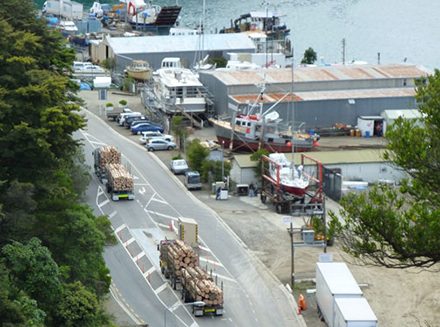
New Zealand is experiencing a collapse in the price of logs sent to China which could mean as many as 1000 people could be out of work according to recent reports. This is before you take into account the repercussions in other industries such as trucking and shipping. Sources: Timberbiz, Radio New Zealand, Business Desk Scoop New Zealand, ANZ Bank
It has become apparent that logs are sitting at ports in China and are not being transported to inland construction projects. This has meant a correction to a trend of good growth for New Zealand that saw export revenue for logs rise from NZ$4.6b in 2015 to NZ$6.3 b in 2018.
New Zealand increased by 23.7% its y-o-y log exports to China to 7.4 million m3 in first five months of 2019, while the average price dropped 7.6% to NZ$95 per m3, according to Stats NZ.
The ANZ Bank has warned that the drop will make the harvest of some woodlots unprofitable. While some price softening is not unusual at this time of year as construction activity slows in the hot months, “the scale of the correction was unexpected,” said ANZ agriculture economist Susan Kilsby.
“The current price level is difficult to quantify as the market has been moving rapidly downwards and in this environment, buyers are unwilling to commit to pricing.”
While some exporters are optimistic the bottom may have been reached “this seems unlikely given the quantity of logs sitting on wharves in China is expected to increase,” Ms Kilsby said.
A number of ships are sitting on the water destined for China without letters of credit. Sales are typically negotiated on a cost and freight basis where the buyer is responsible for the freight costs. This means for a portion of the logs on the water, the sales process has not been completed, she says.
New Zealand has steadily increased its share of the China log market in recent years to become the largest supplier of logs to China.
The quantity of logs sitting on wharves in China has lifted to about twice the normal level. While that is not unusual for this time of year, Kilsby says the figure is likely to grow due to the volume of logs currently on the water.
She says harvesting activity is slowing in New Zealand as a result of the lower returns. Some harvesting crews have been laid off while others are having volume restrictions placed on them.
The drop in harvesting is expected to primarily occur in the smaller woodlots due to the one-off nature of this revenue. The larger forest owners are more likely to continue harvesting as lower returns from the current spot market will be offset in some cases by contracts already in place, and will be more readily absorbed due to receiving continuous revenue from harvesting.
However, any slowing of felling activity will help the oversupply situation and therefore will assist, or at the least reduce further price falls.
According to Ms Kilsby a substantial improvement in prices is not likely to occur in the short-term and it may take six months for a marked lift in price, as existing stocks need to be worked through and buyer confidence needs to rebuild.
“The drop in pricing may now help other markets be more competitive. But it will still be a challenge to divert a significant volume of logs into other markets given that China currently accounts for approximately 80% of all the logs exported from New Zealand,” Ms Kilsby said.
According to New Zealand Forest Industry Contractors Association president Ross Davis the problem has hit all the way down the line.
“There are about 200 (small) contractors, with an average of four to six people in each crew, plus contractors to fix their machinery and sell them spare parts, so it has quite a big impact,” he told RNZ. “The other effect is that there will be a lot of logging trucks parked up.”
NZ Forest Owners’ Association chief executive officer David Rhodes blamed the problem on several things, such as European growers cutting down their trees early to avoid an encroaching pest, the spruce beetle, and sending the logs en masse to China before they were infected. But it was not just Europe that produced the glut of supply in China.
“New Zealand itself has been a large contributor to the volume that has been going into China,” Mr Rhodes said. “I mean, we are up 20% on last year.”
Mr Rhodes said some New Zealand growers would definitely stop selling to China at the new low rates demanded by their customers. But it would take a while for this to work its way through the market.
A background briefing given out by the forestry industry gave more details on the problem.
Along with the spruce beetle, an added impetus was China’s Belt and Road policy, which saw 30 trains leaving Chongqing each week laden with goods for Duisburg in Germany. Rather than return to China empty, the wagons were being loaded with logs for the journey back across Russia to China.
Mr Rhodes and another expert, Reece Brick, of AgriHQ, had another explanation for the problem: China’s trade war with the United States. This had lowered the value of the Chinese currency, making imports more expensive. It had also harmed business confidence in China. As a result, logs were piling up on the docks in China, and not moving to customers inland. That led importers to refuse to take any more, except at a discount.





